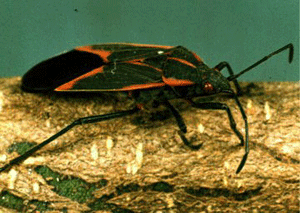Description
The primary host plant of the boxelder bug is the female (seed-bearing) boxelder tree where they feed by sucking plant juices. Boxelder bugs have also been observed on male boxelder, ash, maple and occasionally on strawberries, grasses, and various other plants, but they usually are incapable of full development on these hosts.
In the spring, after emerging from overwintering sites, adult females deposit small, red, oval eggs on host plants. Other eggs may be laid on deposits of boxelder, ash, maple or elm seeds which accumulate near the home. Bright red nymphs hatch from eggs in 10 to 14 days. Nymphs suck plant sap until mid-summer when they mature into adults. These adults lay eggs for a second generation. After maturing, second generation adults seek overwintering sites. Activity continues well beyond frost as insects sun themselves on vertical walls on warm fall afternoons.
When seeking an overwintering site, boxelder bugs often enter buildings through small openings around windows, doors, conduits, and pipes and through small cracks in or above the foundation. Large numbers may be seen around foundations when seeking entry. Inside the home boxelder bugs may stain curtains and walls. They do not damage food or other items in the home, nor do they bite humans or pets.
Some homeowners report effective, cheap control by spraying a soap mixture on the nymphs and adults as they begin congregating in late summer. The spray consists of about 1/2 cup of a laundry detergent in one gallon of water applied by a hand sprayer or squirt bottle directly on the boxelder bugs as often as necessary. The soap mixtures kills only the bugs sprayed, but does not prevent others from coming to the site. Test the mixture first on an inconspicuous spot before application as it might stain cedar and other siding.
Removing boxelder trees from the premises may help reduce boxelder bug numbers. However, since the adults are good flyers, even homes at a considerable distance from host trees may be invaded. Wide-area removal of boxelder trees is not suggested, as the shade value of these trees is more important than the nuisance caused by the bugs. When planting shade trees, preference should be given to species other than boxelder, their preferred host.
Plants are seldom injured seriously enough to justify insecticidal control. However, when large numbers of young bugs are observed on boxelder trees, insecticidal sprays will reduce the number that reach maturity and become nuisance pests during the fall, winter, and spring.
Management

